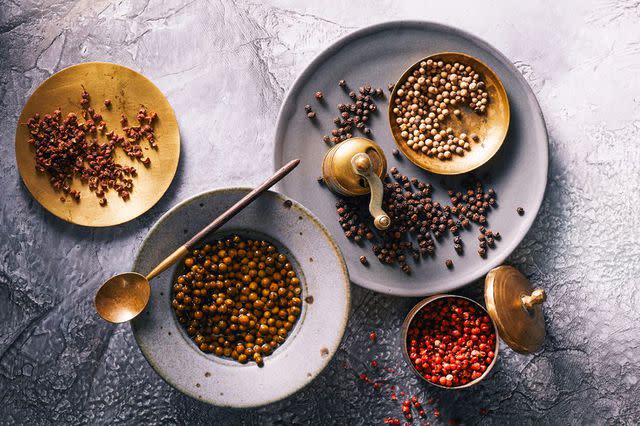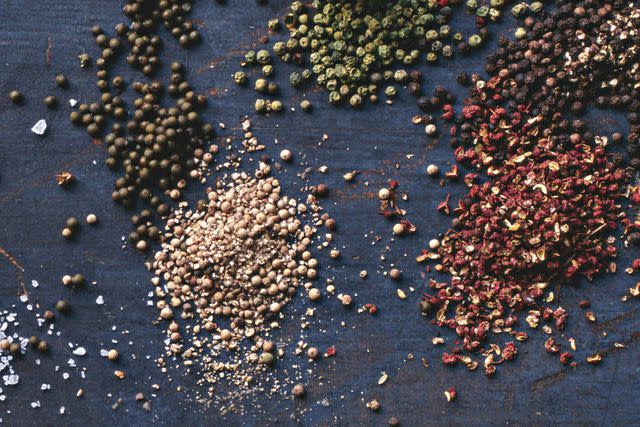How to Use All Kinds of Peppercorns, From Black and White to Pink
Learn which types of peppercorns pack the most heat and flavor.
Given ground pepper's ubiquity and reliability as a seasoning, it's no wonder that many home cooks take it—and its source, peppercorns—for granted. Though we lump its many varieties, from black and white to green, pink, and more, into one amorphous category, each one is incredibly nuanced—a hint, perhaps, as to why this spice was considered a luxury item during the Middle Ages (and among the first to be traded on the Silk Road).
We turned to two spice experts to learn more about peppercorns, the best ways to use each one, and the world of flavor every variety offers.
Related: What Are Finishing Salts, and When Should You Use Each One?
What Are Peppercorns?
Peppercorns are actually a small fruit native to India and Southeast Asia, and are typically grown in tropical climates. Red, green, black, and white peppercorns are all the same berries from the perennial vine called piper nigrum, says Laura Frankel, product development specialist for The Spice House, an online spice company.
"The fruit of piper nigrum is a drupe (similar to stone fruits), meaning that it consists of a seed surrounded by a layer of flesh," says Jennifer Kellison, director of innovation for the member-owned cooperative, Frontier Co-Op, and Simply Organic, which both sell top-flight spices and herbs.

Chris Simpson
Types of Peppercorns
How can one plant yield such a variety of hues and flavor profiles? It's part of peppercorns' wonder. Here, we explore the most popular types.
Black, Green, and White Peppercorns
The harvesting and processing approach dictates the type or color of pepper, says Kellison. "Black peppercorns are harvested while the berries are still green, then sun-dried which causes the outer layer to wrinkle and darken," she says. "Green peppercorns are harvested young when the fruit is unripe. White peppercorns are black peppercorns that are soaked to remove their outer casing." (The less-common red variety ripens until it turns red.) But not all peppercorns stem from piper nigrum.
Pink Peppercorns
Pink peppercorns, also known as Baies roses or pink berries, come from the flowering plant, Schinus terebinthifolius (Brazilian pepper tree) and its relation, Schinus molle, (Peruvian pepper tree) an evergreen shrub; both belong to the cashew family.
Szechuan Peppercorns
Szechuan peppercorns are the tiny berries of the prickly ash tree, which is part of the citrus family. "These berries are harvested only once a year and are dried out in the sun where they burst open to reveal their distinctive floral shape," says Frankel.
Another major distinction: "Pink and Szechuan peppercorns aren’t related to black, white, and green peppercorns," says Kellison.
Taste Differences and Uses
Peppercorn flavors are all over the map, each complementing different dishes.
For Everyday Use: Black Peppercorns
Perfect for everyday use, black peppercorns have a sharp bite and add a touch of heat. Tellicherry black peppercorns from India's Malabar Coast are less spice-forward, offering more complex, distinct citrus notes, while Kampot black peppercorns, a cultivar named for a region in Cambodia, are slightly sweet with a pungent aroma.
Best Dishes: Black peppercorns lend depth to stews, sauces, vegetables, meats, and salad dressings. They also star in dishes like cacio e pepe and steak au poivre. (Note that some recipes use green peppercorns or a mix. Kellison finds that the black peppercorn's citrus and pine notes enhance a steak's umami flavor.)
For Milder Heat: White Peppercorns
Imparting a milder, softer heat, the white type has a unique aroma and flavor. "This makes it a great flavor builder that adds earthy, complex notes to a dish," says Kellison.
Dishes: Typically used in French cuisine, white peppercorns boost the visual effect of white and lighter-colored sauces.
A Fruity Flavor: Green Peppercorns
Green peppercorns "are fruity, bright, and not nearly as piquant as black and white peppercorns," says Frankel. A specialty version is commonly preserved in brine. "But you can also find green peppercorns that are dehydrated similar to black peppercorns—those still bring some heat, but it's mixed with a fresh, herbaceous flavor," says Kellison.
Best Dishes: Green peppercorns enhance French, Creole, Vietnamese, and Thai food, fish recipes, and sauces.
Almost Sweet: Pink Peppercorns
Considered a gourmet item, pink peppercorns boast a novel color, smooth surface, slightly sweet taste, and floral and fruity notes.
Best Dishes: "They are beautiful and delicious with seafood, butter-based sauces, and crushed with your fingers and sprinkled on strawberries," says Frankel.
Pungent and Complex: Szechuan Peppercorns
Essential to Szechuan cuisine, these peppercorns have an unusual pungent flavor and complexity. "Red Szechuan peppercorns are earthy and deeply flavored while the more rare green Szechuan peppercorn is floral," says Frankel. "Both are citrusy with a lip- and tongue-numbing sensation that enlivens flavors," she says.
Best Dishes: Dan Dan noodles, Mapo tofu, and Kung Pao chicken all feature Szechuan peppercorns. They can also take a nontraditional direction, says Frankel, noting that the distinct citrus notes pair well with the cinnamon and cloves in custards, ice cream, cakes, and even pumpkin spice recipes.
Whole vs. Ground

Con Poulos
There's no comparison—when it comes to flavor, freshly-ground peppercorns beat pre-ground pepper every time. It's definitely worth grinding them for your cooking.
Pre-Ground Pepper
The pepper in your shaker is, of course, ground peppercorns. Though convenient for everyday use, pre-ground pepper falls short of delivering the whole spice experience.
"Locked into each peppercorn are the volatile oils. Once ground, the oils dissipate and the flavor is lost. Freshly ground or cracked pepper is a whole other level of exciting flavor," says Frankel.
Whole Pepper
Using a pepper mill (or a mortar and pestle or electric spice grinder), you can grind your own peppercorns and customize the texture. Choose fine ground if you want the pepper to easily blend into dishes or course ground, for a bigger hit of heat.
Texture
Not sure how to choose between fine or course? It ultimately depends on what you're cooking. The texture is particularly paramount in dishes like steak au poivre. "The key is the grind—coarse ground or cracked peppercorns are the best choices for forming the pepper crust," says Kellison.
Definition
Cracked pepper is whole peppercorns crushed into smaller pieces.
How to Maximize the Taste of Peppercorns
These two pointers will help you get the most out of your peppercorns:
Toasting: To heighten the flavors and aroma, Frankel suggests toasting whole peppercorns before grinding. Using a dry skillet over medium heat, stir the peppercorns for three to five minutes to open them up and release the oils.
Storage: As with most spices, peppercorns should be stored in an airtight container, in a cool, dry cabinet. Their shelf life is about a year.
Read the original article on Martha Stewart.

